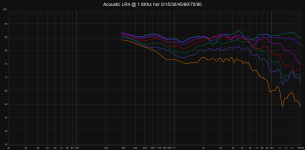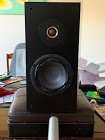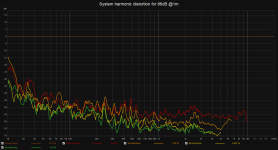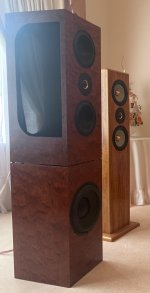yes, that is one aspect. other factors are that shorter stroke and less back pressure allows for a thinner and lighter cone and a narrower and lighter surround which leads to higher Sd. In addition there is less need for ventilation below the dustcap. all this improves sensitivity and helps make the FR smoother and allow higher BW@ Lars, so for the planned mid, you basically trade VC length for a higher BL?
8 ohms is a given. could even consider 16 ohms to match the voltage sensitivity of smaller woofers.I like, but please do an 8 Ω ohm version, 4 Ω doesn't work for my needs ... I guess that'll end up exceeding 93dB @ 8 Ω paper?
High sensitivity midrange would be a great ATC mid dome alternative. I would like to see one with high SPL output capability.
SPL is limited by excursion and/or power. So higher sensitivity gives more SPL when above the excursion limited frequency
Not sure what you mean? All woofers can do 20Hz - the question is how much SPL at 20Hz. We come with bigger woofers that can do more SPL at 20Hz and should do 500Hz as wellHow about something for the 20-500 band?
Hello Lars,
have you plans to release also a 8" or maybe a 10" alu cone woofer?
Thanks,
Roland
Hi Roland, we just got the first 8” alu cone woofer prototype up running in the lab. Looks very promising. Will undergo the usual tweaking and testing before it is released to production. Stay tuned. There is also a 10” in the planning/design phase.
cheers, Lars
Hi Lars A big thanks for your time here.
The impression I get from your comments is that in the case of a nominal 4 inch drive a number of the constraints become relaxed so that higher efficiency/SPL become easier to achieve along with a flatter FR.
Does it also follow that these relaxed constraints lead to a reduction in distortion measures. Put another way, are the distortion measures better for the 4 than we see with the already impressive 6.5.
Best James
The impression I get from your comments is that in the case of a nominal 4 inch drive a number of the constraints become relaxed so that higher efficiency/SPL become easier to achieve along with a flatter FR.
Does it also follow that these relaxed constraints lead to a reduction in distortion measures. Put another way, are the distortion measures better for the 4 than we see with the already impressive 6.5.
Best James
Hi James,
No the opposite,
Non-linear distortion, which includes harmonic and intermodulation distortion, is dependent upon volume displacement below the excursion limited frequency.
So a larger driver will have higher SPL and lower distortion below the excursion limited frequency.
The advantage of the smaller driver is the dispersion.
For instance, relative to on-axis, at 60 degrees off axis, the 4" PTT is ~4dB down at 3Khz, whereas the 6.5 PTT is already 10dB down.
So in designs where I want to focus on good and smooth dispersion/power response/directivity, in a 2 way with a larger mid-woofer I need cross as low as my tweeter will allow. In the case of the PTT6.5, I used LR4 1.8KHz. See attached gated (unsmoothed) measurements of my 2-way with the SEAS Millennium T25-CF002 tweeter.
This is as good as it gets with a standard flat faced tweeter. It's all a matter of geometry.
For an even smoother transition in the 700-2Khz range, one would need use a smaller mid-woofer drive unit.
Or add a midrange driver (3-way)
Or use a waveguided tweeter...
No the opposite,
Non-linear distortion, which includes harmonic and intermodulation distortion, is dependent upon volume displacement below the excursion limited frequency.
So a larger driver will have higher SPL and lower distortion below the excursion limited frequency.
The advantage of the smaller driver is the dispersion.
For instance, relative to on-axis, at 60 degrees off axis, the 4" PTT is ~4dB down at 3Khz, whereas the 6.5 PTT is already 10dB down.
So in designs where I want to focus on good and smooth dispersion/power response/directivity, in a 2 way with a larger mid-woofer I need cross as low as my tweeter will allow. In the case of the PTT6.5, I used LR4 1.8KHz. See attached gated (unsmoothed) measurements of my 2-way with the SEAS Millennium T25-CF002 tweeter.
This is as good as it gets with a standard flat faced tweeter. It's all a matter of geometry.
For an even smoother transition in the 700-2Khz range, one would need use a smaller mid-woofer drive unit.
Or add a midrange driver (3-way)
Or use a waveguided tweeter...
Attachments
Last edited:
Hi Lars,
Thanks for stopping by and giving us some mind food. Can you give us an insight to the little tweaks that have been made to the original 6.5 long stroker over time and what/why/how these were done? Noticed over at ASR they've got a build that ran into trouble with differing woofer responses, seemingly due to the date the woofer was purchased and that the data sheet has been revised a few times for the woofer. It looks like the improvements are for the better, which is good.
Cheers
Thanks for stopping by and giving us some mind food. Can you give us an insight to the little tweaks that have been made to the original 6.5 long stroker over time and what/why/how these were done? Noticed over at ASR they've got a build that ran into trouble with differing woofer responses, seemingly due to the date the woofer was purchased and that the data sheet has been revised a few times for the woofer. It looks like the improvements are for the better, which is good.
Cheers
Looking forward to read about the specifications of the 8" unit, could be very nice for open baffle.
And a 10 - or bigger - even better
Being useable on an OB ... dramatically improving the ~directivity as implemented~ of these SOTA drivers, hence the most effective way of minimising room acoustics
Purifi business case support: customers would almost certainly want two drivers per side .. AND an 8 inch for for the upper bass-lower mids
Imo, would be the marriage of SOTA drivers and SOTA speaker design. I've never read a review which wasn't super impressed eg
"I had heard "not everyone likes the dipole sound ... but ..
I had a chance to visit Linkwitzlab and hear the LX521 and LXMini this weekend. : audiophile
LX521 Linkwitz Lab Open Baffle 4-Way Kit
Last edited:
Hi Lars A big thanks for your time here.
The impression I get from your comments is that in the case of a nominal 4 inch drive a number of the constraints become relaxed so that higher efficiency/SPL become easier to achieve along with a flatter FR.
Does it also follow that these relaxed constraints lead to a reduction in distortion measures. Put another way, are the distortion measures better for the 4 than we see with the already impressive 6.5.
Best James
Hi James, thank you. I agree with tktran that the oposite is more true: cone/suspension distortion comes from flexing and excursion so larger sized drivers can generally have lower distortion for the same SPL (assuming that the motor does not dominate)
Hi James,
No the opposite,
Non-linear distortion, which includes harmonic and intermodulation distortion, is dependent upon volume displacement below the excursion limited frequency.
So a larger driver will have higher SPL and lower distortion below the excursion limited frequency.
The advantage of the smaller driver is the dispersion.
For instance, relative to on-axis, at 60 degrees off axis, the 4" PTT is ~4dB down at 3Khz, whereas the 6.5 PTT is already 10dB down.
So in designs where I want to focus on good and smooth dispersion/power response/directivity, in a 2 way with a larger mid-woofer I need cross as low as my tweeter will allow. In the case of the PTT6.5, I used LR4 1.8KHz. See attached gated (unsmoothed) measurements of my 2-way with the SEAS Millennium T25-CF002 tweeter.
This is as good as it gets with a standard flat faced tweeter. It's all a matter of geometry.
For an even smoother transition in the 700-2Khz range, one would need use a smaller mid-woofer drive unit.
Or add a midrange driver (3-way)
Or use a waveguided tweeter...
Hi tktran, yes, the overwhelming drawback of a larger driver is the poorer dispersion. Congrats with a nice build!
Hi Lars,
Thanks for stopping by and giving us some mind food. Can you give us an insight to the little tweaks that have been made to the original 6.5 long stroker over time and what/why/how these were done? Noticed over at ASR they've got a build that ran into trouble with differing woofer responses, seemingly due to the date the woofer was purchased and that the data sheet has been revised a few times for the woofer. It looks like the improvements are for the better, which is good.
Cheers
Hi mainframe, the 6.5X has only been releaed in an A and B version and this transition was quite a while ago. The B version uses a matte surround and got a custom design terminal block. Some tweaks on the assembly method was introduced and the FR became a bit nicer. Note that the data sheet is updated regularly and independently of the driver version. We have added more data and improved the measurement methods etc.
Cheers, Lars
Yes the Purifi 6.5” is a clear leader in a 2 way under 1/2cu foot; a quad will be great in 2cu foot.
I’m sure you’re aware that a quad in series parallel is as sensitive as a par in parallel, but with twice the power handling (and cost)
But I politely disagree with Joe’s methodology or process, unless of course you only want to have to 6.5” woofers . But Elsonores aren’t in a narrow cabinet.
But yes, many 6.5” drivers can be replaced be replaced by the Purifi 6.5. It has the same dimensions as another Scandinavian driver. I’ve lot of work ahead Purifi’ing some speakers (see below my decades old speakers)
With a clean slate; in a 11” wide cabinet like the Elsonore, I’d parallel three 16 ohm woofers that Lars is developing eg. 8”-10”; that will give you 4 ohms sensitivity in the bass, then I would pair it to high sensitivity small midrange Purifi (4-5”). I’d take polars seriously, and aim for stratosphere eg. Revel or Genelec.
But higher sensitivity (dynamic range) and lower distortion, with bullet proof bass.
I’m looking forward to seeing how Purifi expand their driver range.
Thank you Lars, Carsten, Bruno and the rest of the team.
I’m sure you’re aware that a quad in series parallel is as sensitive as a par in parallel, but with twice the power handling (and cost)
But I politely disagree with Joe’s methodology or process, unless of course you only want to have to 6.5” woofers . But Elsonores aren’t in a narrow cabinet.
But yes, many 6.5” drivers can be replaced be replaced by the Purifi 6.5. It has the same dimensions as another Scandinavian driver. I’ve lot of work ahead Purifi’ing some speakers (see below my decades old speakers)
With a clean slate; in a 11” wide cabinet like the Elsonore, I’d parallel three 16 ohm woofers that Lars is developing eg. 8”-10”; that will give you 4 ohms sensitivity in the bass, then I would pair it to high sensitivity small midrange Purifi (4-5”). I’d take polars seriously, and aim for stratosphere eg. Revel or Genelec.
But higher sensitivity (dynamic range) and lower distortion, with bullet proof bass.
I’m looking forward to seeing how Purifi expand their driver range.
Thank you Lars, Carsten, Bruno and the rest of the team.
Attachments
Last edited:
hi tktran,
Sounds great! I will pass your words on to the team here. Good to have supporters down under.
Note that the power sensitivity always scale with the number of drivers so 4 drivers gives +6dB in power sensitivity (dB SPL /1W) and the max SPL is 12dB higher. Maybe that was also what you wrote.
Cheers,
Lars
Sounds great! I will pass your words on to the team here. Good to have supporters down under.
Note that the power sensitivity always scale with the number of drivers so 4 drivers gives +6dB in power sensitivity (dB SPL /1W) and the max SPL is 12dB higher. Maybe that was also what you wrote.
Cheers,
Lars
Yes the Purifi 6.5” is a clear leader in a 2 way under 1/2cu foot; a quad will be great in 2cu foot.
I’m sure you’re aware that a quad in series parallel is as sensitive as a par in parallel, but with twice the power handling (and cost)
Any doubling of the number of drivers leads to a doubling in efficiency (3dB SPL). So a pair in parallel at a given voltage will produce 4 times the SPL (6dB). One doubling is from the efficiency gain, the other from the doubling of the electrical power.
Proviso: this happens for wavelengths that are large compared to the drivers, so that they are coincident.
In addition: it is bad practice to feed both low drivers in an MTM with the same signal because at higher frequencies, the drivers will no longer be coincident and they will start to beam. It is therefore mandatory to feed one of those two drivers with a signal that is low pass filtered as compared to the other, a 1st order is best.
A quad is an array and will beam in two directions. Only OK for PA.
In addition: it is bad practice to feed both low drivers in an MTM with the same signal because at higher frequencies, the drivers will no longer be coincident and they will start to beam. It is therefore mandatory to feed one of those two drivers with a signal that is low pass filtered as compared to the other, a 1st order is best.
Reading that I though "mandatory is rather absolute for a field as wide open as HiFi speakers, Joseph D'Appolito offered a nice solution in 1983".
AES E-Library >> A Geometric Approach to Eliminating Lobing Error in Multiway Loudspeakers
Back to our specific topic. It occurs a D'Appolito array using Purifi PTT6.5s is a path we have I believe yet to explore. Certainly in 2021 D'Appolito architecture is not as popular as its heyday in the 80s & 90s but dang a 30ish liter box with a pair of PTT6.5s flanking a high output tweeter would certainly be interesting. And by 'interesting' I mean enough output to rock the house and stun small birds at 20 meters.
While I agree and interested, I only have a pair of 4 ohm ptt6.5.Reading that I though "mandatory is rather absolute for a field as wide open as HiFi speakers, Joseph D'Appolito offered a nice solution in 1983".
AES E-Library >> A Geometric Approach to Eliminating Lobing Error in Multiway Loudspeakers
Back to our specific topic. It occurs a D'Appolito array using Purifi PTT6.5s is a path we have I believe yet to explore. Certainly in 2021 D'Appolito architecture is not as popular as its heyday in the 80s & 90s but dang a 30ish liter box with a pair of PTT6.5s flanking a high output tweeter would certainly be interesting. And by 'interesting' I mean enough output to rock the house and stun small birds at 20 meters.
Is it ok to wire the 2 woofers in series? Otherwise, I will have to purchase 2 extra pairs instead of one.
- Home
- Loudspeakers
- Multi-Way
- Exploring Purifi Woofer Speaker Builds



